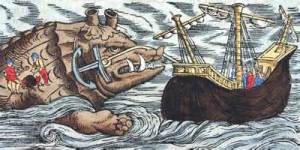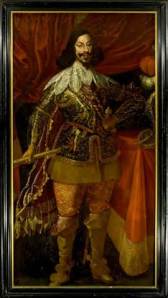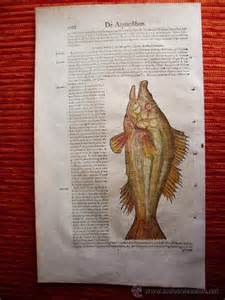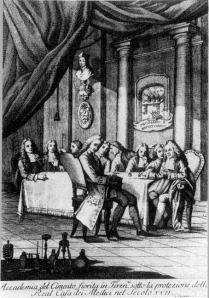One dark morning in October 1666 several boats of fishermen unloaded the body of a shark they had taken offshore from Livorno just south of Pisa, in Tuscany. So big was this specimen that its capture attracted attention at the little port and the brave fishermen became local heroes for bringing it ashore without any loss of life. Their employer was the Grand Duke Ferdinand II , an enlightened, questioning member of the nobility. As soon as he heard about the landing of an unusual fish he felt a surge of excitement.
Ferdinand was a generous benefactor to the local university and was interested to support the new kinds of scientific enquiry in astronomy and features of the earth. So the giant shark was bound to pique his curiosity. By chance, Ferdinand had just heard that a 27 year old anatomist called Nicolas Steno (1638-1686) had arrived in Florence as visiting professor: surely he would be able to offer some scientific opinion? So the specimen was sent the few kilometres to Florence to be examined by one of the world’s first biological scientists for the most up-to-date opinions that were possible. Steno’s family were goldsmiths and he had enough money to travel around Europe establishing his reputation as an anatomist, making use of his particularly fine skills of observation. He had also been influenced by the scientific argument that he had found firstly in Paris and then at the new Experimental Academy in Florence, recently founded by Duke Ferdinand’s brother, Leopold de’ Medici, to perpetuate and extend the experimental and mathematical work of Galileo.
The fish was much larger than any shark that Steno had seen before and reminded him of the drawings made more than a hundred years earlier by the Italian naturalist and collector Conrad Gessner. That fish was smaller than the latest specimen though the picture showed its aggressive mouth wide open to reveal enormous teeth, teeth which Gessner had proposed to account for the well-known “tongue stones” commonly found within the sedimentary rocks outcropping in that part of Italy. These striking objects were well-known in the villagers’ folk-lore and there were many different ideas of what they were and how they got into the hard rocks. Gessner’s suggestion that the stones were the broken-off teeth of a shark was not popular. It sounded ridiculous to most people that fish teeth should have found their way into the structure of inorganic rock. But from his precise comparative observations Steno had conclusive evidence that the structures from organic and inorganic sources were the same size. The two kinds of object were from giant sharks, one kind living, the other kind fossilised in the rock.
Sixteenth century scientists like Gessner had collected specimens of crystals and other rocks, as well as petrified wood and shells, and took them together as artefacts of the inorganic earth. All such things were called “fossils” and because they were all made of different kinds of rock they were thought to have formed with the earth, not from any living source. There wasn’t even a question that they may have once been living because there was nothing like them today. Even the tongue-stones were much bigger than the teeth of any living fish that Steno thought they resembled. Most observers seemed to be happy that all these things came from the inorganic earth and had never had anything to do with living creatures. There was no need for any such complex explanation as the one Steno proposed. Fossils were simple relics of the earth, bits of rock.
But by the middle of the seventeenth century more collectors were beginning to think differently and Steno’s interpretation of the tongue-stones attracted more attention. He also had fossils of exquisitely preserved crabs and molluscs that were as life-like as many of the familiar species found in Europe. But he also had some of these familiar sea shells from sedimentary rocks high up in the mountains. The trouble with them was whether they got there by The Flood or whether they were the remains of some animals yet to be discovered alive. They were two different answers to the questions raised by the tongue-stones and which still puzzled most naturalists. But still, for Steno, the Tuscany shark settled the issue: that many things previously thought to be earthly remains were the fossilised relics of dead animals and plants.
It had become a tradition to explain the dilemma presented by those fossil specimens found out of range, high up at the top of mountains, by the eighth chapter of Genesis in the Old Testament that allowed either option:
Now the flood was on the earth forty days. The waters increased and lifted up the ark, and it rose high above the earth. The waters prevailed and greatly increased on the earth, and the ark moved about on the surface of the waters. And the waters prevailed exceedingly on the earth, and all the high hills under the whole heaven were covered. The waters prevailed fifteen cubits upward, and the mountains were covered…. Only Noah and those who were with him in the ark remained alive. And the waters prevailed on the earth one hundred and fifty days.
But in 1667, opting for the path of rationality with his expert dissection of the giant shark from Tuscany, Steno published his drawings of the large teeth and was able to compare these to other pictures of several living species. The similarities were clear and he offered them as his proof that the tongue stones were once part of a very large living shark: “how well then everything agrees, how unanimously they all point in the same direction.” Steno’s book was noticed in England by one of Francis Bacon’s most enthusiastic supporters, recently appointed as The Royal Society’s first Curator of Experiments. Robert Hooke (1635-1703) had also met Steno in Montpellier in 1665 and clearly remembered the talk about the local legends of the infamous tongue stones. Hooke saw to it that an abstract of Steno’s paper appeared in the Philosophical Transactions, a news-sheet that had just begun to be circulated to fellows. Hooke was an important influence in the new community of scientists, making air pumps and time-pieces for his old friends interested in chemistry and biology who he had met at Oxford.
The work encouraged Hooke and others to make further comparisons between fossils and living things, using another piece of new technology about which he was greatly excited, his microscope.
Already he had compared the microscopic cellular structure of some fossil wood with that in a thin section of freshly made charcoal. It showed him the big cells that had formed by the fastest growth in the Spring-time and how these spread round the circumference of the tree-trunk to make the now-familiar growth rings. Hooke was satisfied with science as a part of the religious outlook, and argued that both philosophies saw the earth as a system with many parts and which enabled such things as earthquakes, floods and fossils. If the earth had originated as a fluid, as some were suggesting, then he accepted that this was also entirely compatible with science and religion. But his enquiring mind must have started to suggest some doubts.
This openness and duality helped Hooke to understand the shark’s teeth in two very different situations: one very much active and alive, the other petrified and dead. Because they both exhibited the same cellular structure they must be manifestations of the same thing and Hooke used both to tell the story of the evolution of these fish to show how they grew and evolved. But the possibility that some were extinct species was not even dreamt of, as that would be tantamount to admitting some inadequacy in God’s design. How the sheer weight of sediment covering the specimens got there was not considered either, just as well because some of the mountain exposures had several hundred meters of overlying strata. Their accumulation would have needed a very deep and persistent flood indeed.
Other kinds of large-scale displays of the earth’s force had just been experienced in Italy, where Vesuvius had erupted in 1631, and the catastrophic flooding from seven rivers flowing around the mountain was fresh in the minds of all the local people. Another source of fear that caused a different kind of caution was the Inquisition, which was then passing judgment on Galileo. It was the start of a niggling suspicion with some of the explanations of life that had been accepted for centuries. Was life caused by some forces not mentioned in the stories of Genesis?
More of these questions were being raised as Steno’s academic work proceeded so that some of his colleagues looked again at the first chapter of Genesis:
I have given you every herb bearing seed, which is on the face of all the earth, and every tree, in which is the fruit of a tree yielding seed; to you it shall be for meat.
And to every beast of the earth, and to every fowl of the air, and to every thing that creepeth upon the earth, wherein there is life, I have given every green herb for meat: and it was good.
The people wanted more justification of the biblical explanations: Francis Bacon had said as much in New Atlantis, but ideas as well as things could still be expected to move slowly in those times.
In his Prodromus (1669) Steno summarised his observations and thoughts arising from his work with the Tuscany shark, setting out his revolutionary ideas about how the earth’s form had been shaped through time. They were ideas that he had previously kept secret, afraid to share them with his seriously religious friends but thoughts, nevertheless, that had become powerful obsessions. Undoubtedly at that time they were ideas that some thought to be blasphemous: that fossils were buried parts of once living organic organisms that had somehow failed.
The work also set out for the first time the basic geological idea that sediments were laid down horizontally and formed layers of rocks, the older covered by the younger and them all containing bits of organisms that had lived at the time of sedimentation. It was one big compromise, pleasing neither the rationalists nor the faithful.
But these were only quiet and trembling whispers and Steno knew that sooner or later the biblical metaphors had to be challenged. He had powerful skills of observation to partner his active curiosity, and unlike most of his contemporaries, he asked questions. Still expecting to explain nature through biblical orthodoxy he suggested six stages in the process of earth formation based on the six days of the creation story. The first two of these involved sediment from the land being washed into the sea and settling on the sea-floor horizontally, two more involved these sediments being consolidated and folded and in the final two stages the resulting rocks were eroded and weathered. The theory was a brilliant reconstruction of geological processes.
Then he went on to try and test the theory by offering new explanations of how life began and how it might then have diversified. By the middle of the seventeenth century there were many naturalists talking about the way the bodies of dead creatures might become trapped by Steno’s sedimentation hypothesis. Indeed, some of these suggestions were so extreme that they presented a growing number of questions about the bible’s explanation of nature, and they made Steno feel very excited about his challenges to the authority of the church.
These dangerously unfashionable ideas isolated Steno further from that early scientific community for there were very few, if any, with whom he could share such extreme yet rational interpretations. He became so troubled that he eventually capitulated to the mainstream and converted to Catholicism. There, his charisma led to him being ordained as a priest in 1675 and he was then appointed as a bishop two years later. He died in 1686 at the age of 48. Nevertheless, his earlier dilemma about where fossils came from continued to trouble many people, especially those not held in check by the church. They were not convinced by the argument that the six stage process was sufficient to establish living things, and they looked to Steno’s old English friend Robert Hooke, and the new procedure to make scientific experiments, for more convincing evidence that might have settled the matter.








